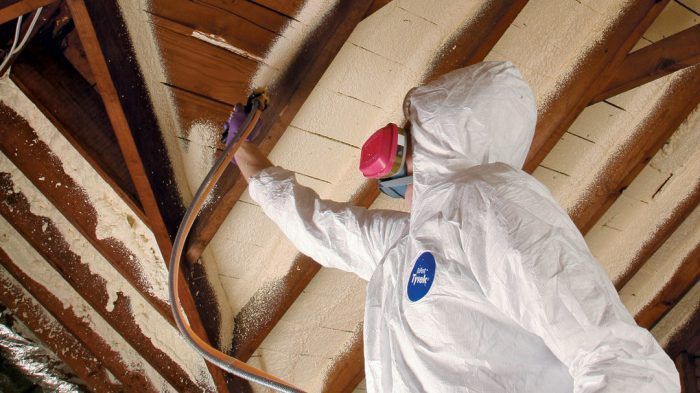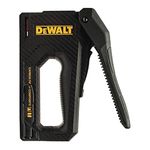Spray-Foam Insulation
Learn about the pros and cons of spray polyurethane foam—a high-performance material found in the walls and roofs of many of today's energy-efficient homes.

Spray-polyurethane-foam insulation is more expensive than other kinds of insulation—fiberglass batts or blown cellulose, for example—and it calls for professional installation. So, why do some builders and homeowners swear by it? In a word, performance.
Spray polyurethane foam comes in two versions: open-cell and closed-cell. Both types fill cracks and crevices in walls and ceilings much more effectively than batt insulation, easily flowing around pipes and wires to create an effective air barrier as it cures.
Spray foam is made at the job site from two chemicals, the “A” and “B” sides. The two mix at the nozzle of the spray gun, foaming as the components are brought together. Installers wear protective clothing and a respirator as they work with it.
Open-cell foam is vapor permeable
Open-cell foam is the lighter and less expensive of the two. With an R-value of between R-3.5 and R-3.6 per in., open-cell foam weighs about 1/2 lb. per cubic ft. Although costs vary, plan on $1 to $1.20 per sq. ft. when filling a 2×4 stud cavity.
Installers typically over-fill a stud or rafter bay with the foam and trim back the excess once the foam has cured. This leaves the cavity completely filled.
Open-cell foam makes a good air barrier, but it’s vapor permeable. That means water vapor can migrate through the foam even when the bulk movement of air is blocked. This becomes an important consideration when the foam is sprayed between rafters on the underside of the roof sheathing to create a conditioned attic in a cold climate. In the winter, moisture in the attic air can make its way through the foam and collect on the back side of the sheathing—a potential mold and decay problem. In this case, a separate vapor retarder or vapor-retarding paint should be installed over the foam.
Closed-cell foam is a vapor barrier
Closed-cell foam has a much higher R-value than open-cell foam — about R-6.5 per inch — and it’s a vapor barrier as well as an air barrier. (One manufacturer, Demilec, says its Heatlok High Lift spray foam has an even higher R-value—R-7.5 per in.) Closed-cell foam is much denser, about 2 lb. per cu. ft., and it’s unaffected by water. It forms a tough, dense insulating layer and reinforces wall and ceiling cavities structurally.
Closed-cell foam also is considerably more expensive than open-cell foam, costing between $1.75 to $3 per sq. ft. in a 2×4 cavity. That’s money well spent in some applications. In a wall or roof where there’s limited space for insulation, for example, closed-cell foam offers excellent thermal performance in a thinner layer than most other kinds of insulation.
Cured closed-cell foam is much harder to trim than open-cell foam, so installers don’t overfill stud and rafter bays. It’s way too much work trimming it back after the foam has cured.
Installers also have to be careful not to spray too much foam in a single pass, or “lift.” The reason is that the foam creates heat as it cures—an exothermic reaction. If the foam is too thick, it can catch on fire. Although this is rare, it has happened, and poorly applied foam has been blamed for several house fires.
Make sure you know what you’re getting
With its very high R-values, closed-cell foam would seem to be an ideal insulation for exterior walls. Just think: In theory, filling a 2×6 stud cavity yields an R-value of 37.75, almost double what a standard-density fiberglass batt would provide.
But, as Green Building Advisor editor Martin Holladay explains in this article, the reality is different. First, the installer will probably not bring the foam all the way out to the edge of the stud. He’s more more likely to leave a 1/2-in. buffer so he won’t have to trim anything back later. Now the insulation layer is 5 in., not 5-1/2 in..
Then there is the “framing factor”—that part of the wall that isn’t insulation: studs, headers, and top and bottom plates. When the R-value of wood (about R-1.2 per in.) is figured into the equation, the whole-wall R-value is more like R-15.4. That’s only R-1.9 more than you’d get with open-cell foam, but at a much higher cost.
Environmental considerations
Despite some undeniable performance benefits, some builders and designers won’t use spray foam. Advocates of foam-free construction don’t like the petrochemical origins of spray foam, or the possibility, however remote, that improperly mixed foam will create a chemical hazard or lingering odors in the house.
And in the case of closed-cell foam, there is the matter of the blowing agent—the chemical additive that gives foam its froth and its high R-value. Open-cell foam uses water or carbon dioxide as the blowing agent, but the industry-standard blowing agent for closed-cell foam has been a hydrofluorocarbon (HFC) with a global warming potential (GWP) some 1300 times higher than carbon dioxide.
With the risks of global warming and climate change becoming better understood, this alone is enough to make some designers run the other way. However, a next-generation blowing agent developed by Honeywell, called Solstice, is a different chemical, a hydrofluoroolefin. It has a GWP of 1 or less, making spray-foam formulations that use it no more harmful in that respect than open-cell foam.
The spray-foam industry is gradually switching over to this newer blowing agent, and the Spray Polyurethane Foam Alliance expects the transition to be complete sometime in the next year or two.
More about insulation and air-sealing:
What’s the Difference: Spray polyurethane-foam insulation – Open cell and closed cell varieties have varying insulating qualities and applications.
Spray Foam for the Rest of Us – When the insulating task is small, a do-it-yourself spray-foam kit may be your best option.
New Technology Improves Airtightness – AeroBarrier uses compressed air to aerosolize a water-based sealant to fill gaps and cracks in an entire house.
Is Using Closed-Cell Foam Worth the Trade-Offs? – This insulation material is popular for its high R-value and good air-sealing and vapor-blocking properties, but cost, health, and environmental concerns cause some builders to have second thoughts.
Fine Homebuilding Recommended Products
Fine Homebuilding receives a commission for items purchased through links on this site, including Amazon Associates and other affiliate advertising programs.

Nitrile Work Gloves

Staple Gun

Insulation Knife






View Comments
Allowing vapor to pass through and cause mold inside in a cold climate is a legitimate concern, your solution makes since. Of further note readers need to be aware of a concern with closed cell on the underside the roof. With closed cell if there is any leak or water infiltration in the roof you wont know until its too late and you have a massive mold or rot problem.
I do not see it mentioned often - - but how about when it is time to remodel a section or house where foam has been used? or running new electrical circuits or HVAC in a cavity where foam was used? and what about fire safety or fire retardancy in a home with foam insulation? I would also ask a first responder at your local fire department what they think about operating in an involved structure that was insulated with spray foam.